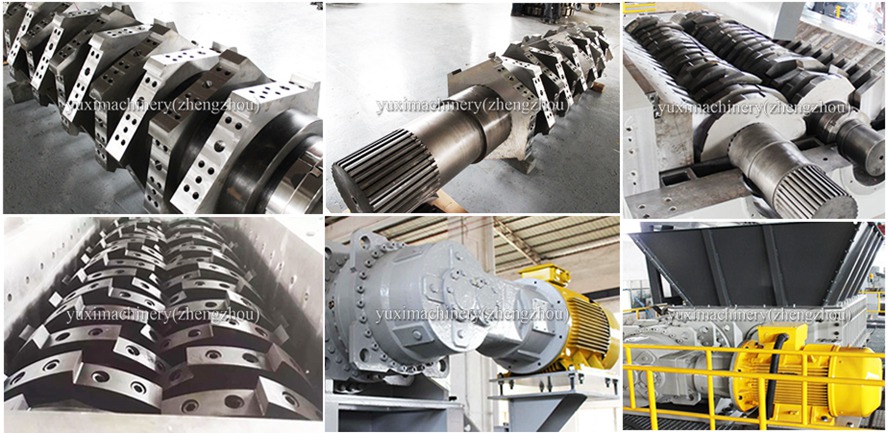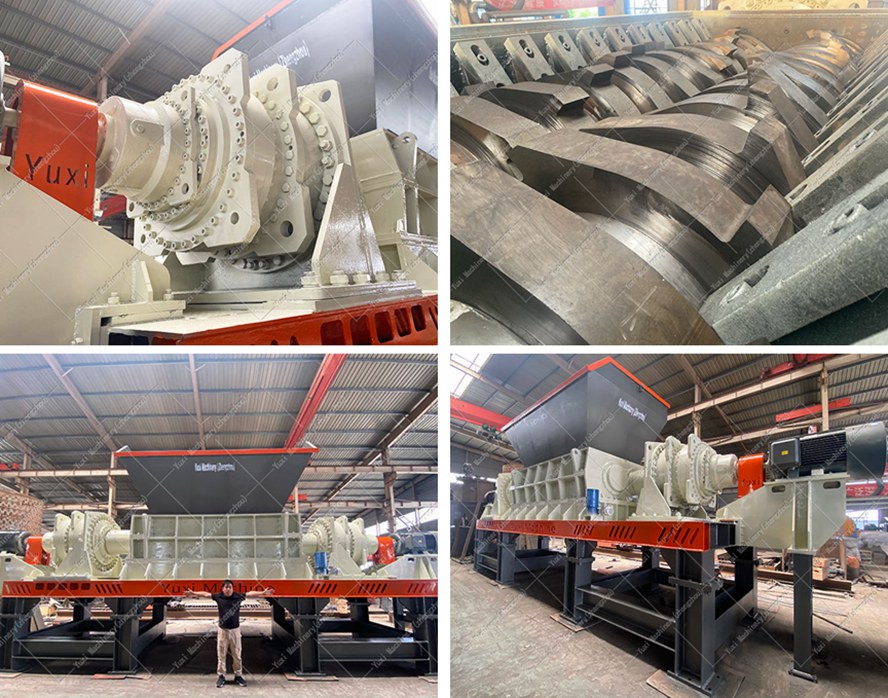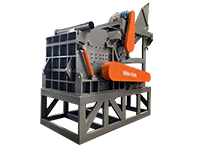In the field of industrial solid waste treatment and resource recycling, the double shaft shredder has become a key device for volume reduction and resource utilization of waste materials due to its unique structural design and efficient crushing performance. This article will conduct a professional and in-depth analysis of it from the dimensions of technical parameters, working principle, core structure, application scenarios, and competitive advantages.
1. Technical Parameters: Precisely Defining the Performance Boundaries of the Equipment
The technical parameters of the double shaft shredder directly determine its processing capacity and applicable scenarios. The core parameters are as follows:
• Feed Size: Conventional models cover 4 - 102 inches, and customized designs are supported, which can meet the feeding requirements from small scraps to large industrial wastes.
• Production Capacity: A wide range of 0.44 - 66 short tons per hour, which can adapt to different scale requirements from laboratory-level small-batch processing to large-scale industrial production.
• Drive System: Adopts a power configuration of "motor + reducer" to achieve a low-speed and high-torque shearing effect, which is a key design for dealing with high-toughness and high-viscosity materials (such as waste tires and rubber).
2. Working Principle: The Efficient Crushing Logic of Dual-Shaft Linkage
The double shaft shredder adopts a double-shaft independent drive structural design. When the two shafts rotate relatively, they extrude, shear, and tear the material. The core advantages of its working principle are reflected in:
• Using the meshing motion of the cutter shaft and rotating cutter to gradually crush the material to the target particle size;
• The unique structural design ensures that the equipment will not have shaft winding or jamming during low-speed and high-torque operation, ensuring production efficiency and equipment stability;
• It has an automatic feeding function. Under the extrusion of the double shafts, the material can continuously enter the crushing chamber to realize streamlined operation.

3. Core Structure: Durability and Efficiency from Component Design
The core structure of the double shaft shredder is the "backbone" of its performance, and the professional design of each component is worthy of in-depth study:
• Cutter System: Made of ASTM standard special alloy steel (high-speed steel or tool steel) through special processing technology, it has the characteristics of good wear resistance, high strength, and repairability. The cutters adopt a helical arrangement and a hexagonal inner hole + hexagonal spindle surface design. The former realizes efficient cutting, and the latter makes the force on the cutters uniform, greatly prolonging the service life.
• Bearing System: Adopts IP69K grade sealing technology, which effectively prevents water and dust, solves the problem that the bearings of traditional shredders are easily damaged due to pollution, and significantly prolongs the service life of the bearings.
• Control System: Equipped with a UL-certified PLC control system, it has start, stop, reverse, and overload automatic reverse control functions, which can realize full automatic control, reduce the cost of manual intervention, and improve operational safety.
• Split Box Design: The cutter shaft (including shaft, blade, bearing, and sealing system) adopts a split box modular design, which is convenient for quick disassembly and maintenance, and greatly shortens the equipment downtime.
4. Application Scenarios: Resource Recycling Solutions for Multiple Industries
With its adaptability to various materials, the double shaft shredder plays a key role in the following industries:
• Solid Waste Treatment Field: It can handle domestic waste, industrial waste, medical waste, solid hazardous waste, etc., realizing volume reduction and subsequent harmless and resource-oriented connection, and meeting EPA environmental protection requirements.
• Resource Recycling Field:
◦ Metal Recycling: Crushes waste metals (such as scrap steel and aluminum products) to provide high-quality raw materials for the smelting process, meeting ASTM metal recycling raw material standards;
◦ Plastic Recycling: Crushes various waste plastics (such as packaging barrels and plastic plates) to facilitate subsequent pelletizing and recycling, complying with ISO plastic recycling pretreatment specifications;
◦ Tire and Rubber Recycling: Crushes waste tires and rubber products into rubber powder for the production of recycled rubber and waterproof materials, meeting the requirements of the EU REACH regulation;
◦ Wood and Textile Recycling: Crushes waste wood and cloth to realize biomass energy utilization or fiber recycling, complying with the environmental protection standards of the California Air Resources Board (CARB).
• Manufacturing Supporting Field: In industries such as electronic manufacturing, plate manufacturing, and papermaking, it is used for the pretreatment of scraps and waste materials to improve raw material utilization, complying with OSHA safety production and raw material utilization standards.

5. Competitive Advantages: Performance Breakthroughs under Technological Iteration
Compared with single-shaft shredders or traditional crushing equipment, the competitive advantage of double shaft shredders comes from multi-dimensional technological optimization:
1. Strong Material Adaptability: It can handle materials with high toughness, high viscosity, and large thickness (such as electronic waste, waste metal, and wood), filling the application gap of traditional equipment and meeting ANSI material handling equipment performance standards.
2. High Operation Stability: The double-shaft independent drive and anti-winding shaft design make it not easy to be blocked when dealing with complex materials, and the equipment utilization rate is significantly improved, complying with NFPA equipment reliability standards.
3. Low Maintenance Cost: The cutters can be repaired, the split box is easy to maintain, and the sealed bearings have a long service life, reducing the equipment operation and maintenance cost from the whole life cycle, and complying with ASME equipment maintenance economic specifications.
4. High Degree of Automation: The UL-certified PLC control system realizes intelligent operation, reduces reliance on manual labor, and conforms to the automation trend of Industry 4.0 and NIST intelligent manufacturing standards.
6. Professional Q&A: In-Depth Q&A
To help readers further understand the double shaft shredder, here are professional answers to several key questions:
1. How to Deal with Worn Cutters of Double Shaft Shredders?
Answer: Since the cutters are made of ASTM standard special alloy steel and are repairable, they can be repaired by processes such as welding and grinding after wear. The performance of the repaired cutters is close to that of new ones, which greatly reduces the cost of cutter replacement and complies with AWS welding repair standards.
2. Do the Cutters of Double Shaft Shredders Need to Be Replaced When Processing Different Materials?
Answer: It is necessary to select suitable cutters according to the hardness, toughness, and shape of the material. For example, ASTM high-hardness alloy cutters can be used for processing hard metals, and helical tooth cutters can be used for processing soft plastics. The equipment supports customized cutter replacement, meeting SAE cutter selection specifications.
3. How to Control Noise and Dust of Double Shaft Shredders?
Answer: The noise generated by the equipment can be reduced by installing a soundproof cover that meets OSHA standards; and by cooperating with an EPA-certified dust removal system (such as a bag filter) and IP69K sealing design, the dust emission during the crushing process can be effectively controlled, meeting the environmental emission requirements of California Proposition 65.
4. How to Determine Whether the Production Capacity of the Double Shaft Shredder Matches Its Own Needs?
Answer: It is necessary to comprehensively consider four factors: material type (density, hardness), feed size, target discharge particle size, and hourly processing capacity, and carry out matching selection in combination with the ANSI equipment production capacity parameter table (or manufacturer's customized plan), complying with API material handling equipment selection specifications.

As a core equipment for resource circulation and solid waste governance, the technological iteration and application expansion of the double shaft shredder are promoting the industry to develop in a more efficient and environmentally friendly direction. Whether from the accuracy of technical parameters or the breadth of application scenarios, it is a key link in modern industrial production and sustainable development.
 Shredding Machine
Shredding Machine
 Waste Recycling Line
Waste Recycling Line
 Optional Equipment
Optional Equipment



